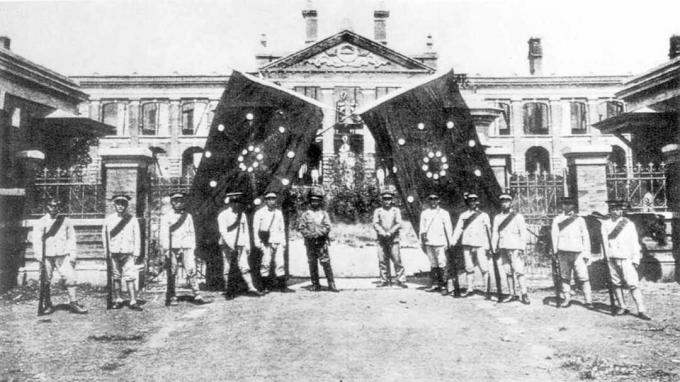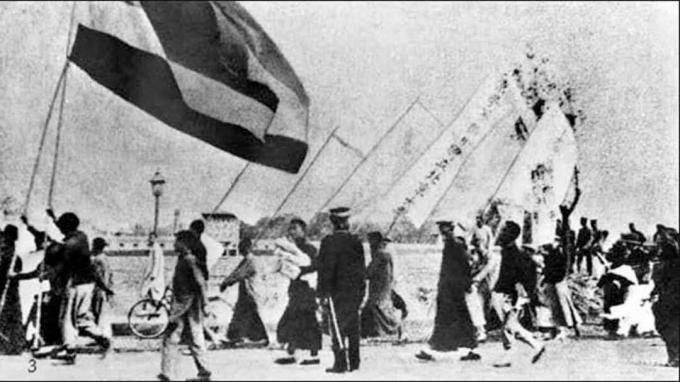Chinese Revolution (Background, Process, Broke, Revolution)
The Chinese Revolution was a revolution that succeeded in defeating the last imperial dynasty in China, the Qing Dynasty.
And founded the Republic of China (ROC), the Chinese Revolution started a series of revolutions that occurred in China during the 20th century.
Table of contents
Chinese Revolution Background

In the modern period China began with the first defeat of the west in the opium war that occurred in 1842.
At that time the ethnic Mancu people who ruled in the Qing court were fighting against foreign intrusion into China.
But efforts to adapt and reform traditional methods of government were limited by a very conservative court culture.
And there is no desire to give too much opportunity to reform.
After the defeat in the second opium war that occurred in 1860. Qing attempted to moderate by adopting western technology and through self-reinforcement from 1861.
In the years 1851-1864 against taiping, 1851 against Nian, 1856-1868 the Yunnan Muslims, and 1862-1877 the western sea.
The traditional imperial forces proved incompetent and demonstrated the weakness of the imperial government.
In 1895 China suffered another defeat in the period of the first Sino-Japanese war.
The defeat showed that traditional Chinese feudal society also needed modernization if it was to achieve technological and commercial gain.
The Qing court frustrated the increasing demands of imperialist demands from Japan and the West. And also the desire to see a unified China encouraged the emergence of nationalist movements that brought a revolutionary idea.
A revolutionary idea brought up by Chinese people living somewhere overseas. Mainly in Southeast Asia and America.
Generally, those academically educated Westerners began to press for revolution or immediate reform.
The establishment of a Constitutional Monarchy was proposed by Kang Youwei and Liang Qichao who were their leaders.
Sun Yat-sen temporarily led the jumbled group together to form the Revolutionary Alliance or Tongmenghui.
The Revolutionary Alliance's mission was to replace a Qing government with a republican government.
Sun is someone who is a nationalist with some socialist tendencies
From revolutionary leaders and Chinese people abroad helped finance their efforts to take root in South China.
In the years leading up to the revolution, the revolutionary alliance made several attempts at rebellion against the Qing, but all of them were stopped by the Qing army.
The Process of the Chinese Revolution

The Chinese Revolution took place on October 11, 1911, led by Dr. Sun Yat Sen and managed to defeat the Qing Dynasty.
The revolution caused the people to be disappointed with the leadership of the Qing Dynasty, a kind of losing the war against the western nations, the failure of the emperors to lead.
And the people are suffering more and more, which makes revolution unavoidable. On January 1, 1912, Dr, Sun Yat Set was appointed President. And the Republic of China is considered to have started on that day.
Dr. Sun Yat Sen resigned as president and created the Kuo Min Tang party. And was replaced by Yuan Shih Kai on February 12, 1912. Yuan Shih Kai's reign did not last long because he died in 1916.
The government was finally led again by Dr. Sun Yat Sen, but only until 1924. The position of Sun Yat Sen was replaced by Chiang Kai Shek and succeeded in uniting the south and north.
But during his reign he had to fight against Mao Zesong who had communist ideology.
Mao Zedong managed to defeat Chiang Kai Shek and finally in 1949 he founded the Communist People's Republic of China.
And while Chiang Kai Shek founded the state of Taiwan. And finally communism is growing in Asia.
The outbreak of the revolution

The revolt in Wunchang had become the starting point for a rebellion on a national scale.
As losses increased, the Qing court's positive response to a series of demands meant to turn the authoritarian empire into a constitutional monarchy.
Yuan Shikai was appointed as the new prime minister of China. But before Yuan Shikai was able to reclaim the territories captured by the revolutionaries.
Allegiance began to be expressed by their provinces to the revolutionary alliance led by Sun Yat Sen.
Dr. Sun was still in the United States on a fundraising tour when the uprising began.
Dr. Sun immediately rushed to London and Paris. To ensure that the two countries did not provide financial or military assistance to the Qing government in its struggles.
The revolutionaries had taken over Nanjing when he returned to China. Nanjing was the former capital city under the Ming Dynasty.
And representatives from the provinces started arriving for the first ever national meeting. Together they chose Dr. Sun as interim president of the newly established Republic of China.
The Premature Revolution

Sun Yat Sen's dream of forming the Republic of China has been achieved. But the process of consolidating the new government was much more difficult than the revolutionaries had anticipated.
The defeat of the Qing dynasty also did not lead to an era of prosperity and peace. Rather, it was a period of social unrest, chaos, disillusionment, and prolonged war.
In collective memory, the Republican era has nothing to do with the rebirth of China. But the warlords of corruption, economic weakness, foreign aggression and civil strife.
There was little effect on the stability of the new country when Sun Yat Sen was appointed interim president.
The Qing dynasty did not give up its title even though the proclamation of the Republic was proclaimed in January 1912. And does not recognize the republican government as a legitimate government.
Since there was no formal abdication, China had two de facto governments, the Republic and the Empire.
The task of Sun Yat Sen was to re-rule the Chinese republic until the time the Qing dynasty resigned and until the state's conditions stabilized.
When Yuan Shikai's revolution emerged as a political he would not be able to last long if he sacrificed himself for the Qing dynasty.
Therefore he then changed his strategy. Then he tried to solve the crisis by ensuring a smooth transition from the empire to the Republic.
Yuan presented himself in the manner of a peacemaker and loyal servant of the new nation.
The imperial family was divided between favoring resignation and wanting to suppress revolution.
Yuan Shikai also explained to the imperial family. If they wanted to fight the revolutionaries they had to set aside 12 million taels for war expenses.
However, the finances of the empire were empty. And no Manchu prince was ready to sacrifice personal wealth for the expense of the army.
On January 26, 1912 the imperial cabinet met at the Yuan Shikai House. 40 high-ranking officers had sent telegrams urging the Manchus to abdicate.
That night the army chief of staff was killed by a fanatical revolutionary on his way home. After the incident the imperial family became afraid of security.
On January 27, the wife of the late Emperor Guangxu and adoptive mother of the last Chinese emperor Puyi. In a panicked state pleaded with deputy Yuan Shikai.
To convey to the general the message that the emperor and his own life are in his hands, that he must save him.
Three days after that incident Longyu made the decision to end the 2,000 year old empire. And he finally agreed to end the reign of the Qing Dynasty.
And revolutionaries who wish to avoid further conflict provide such special privileges. The emperor retained his title and was treated by the Republican government with respect.
Among these he would receive an annuity, and be allowed to live in the imperial court and continue to perform traditional religious rituals.
The Queen issued an Abdication Decree containing the transfer of power to the Republican Government on February 12 (Emperor Xuantong's reign). Under this decree Yuan Shikai was granted the authority to reorganize China.
Following the news of his resignation, Sun Yat Sen expressed his willingness to resign immediately. And finally fulfilled the oath to be the Interim President.
This selfless act earned great respect among the Chinese. But in the long term this action proved unwise.
Yuan Shikai was urged by Sun to give up the power that had been given by the Manchus. Because the emperor has no right to grant such power.
Only the people have the right to have this right. But Sun was too naive to accept Yuan Shikai's promise that he would defend and serve the Republic.
Sun Yat Sen advised the National Assembly in Nanjing to elect Yuan Shikai as President.
Election is a historic thing in Guomindang and China emerged as the most possessive power in China.
The party won 169 seats out of 596 in the People's Representative Council. And 123 of 274 in the Senate, so the position of the guomindang in the best position to govern the government.
And Yuan Shikai was required to resign and a democratically elected parliament could appoint a new president.
When Sun Yat Sen and the revolutionaries had put their trust in Yuan Shikai they made a mistake.
Instead of relinquishing the presidency as promised, Yuan ordered the assassination of Song Jiaoren. Song jiaoren was one of the leading leaders in Guomindang.
Thereafter Yuan banned 438 of the Guomindang members from parliament and subsequently dissolved the parliament itself. He abolished and declared himself emperor in 1916.
But it caused enormous public outrage and was impossible to ignore. Because it becomes a fear in case of civil unrest.
He restored the Republic again, but continued to rule in a dictatorial manner until his death in June 1916.
When Yuan's reign ended, the Republic of China finally collapsed. And the warlords seized power, and created a personal kingdom over which the king ruled. And apart from the central government which is only a name.
